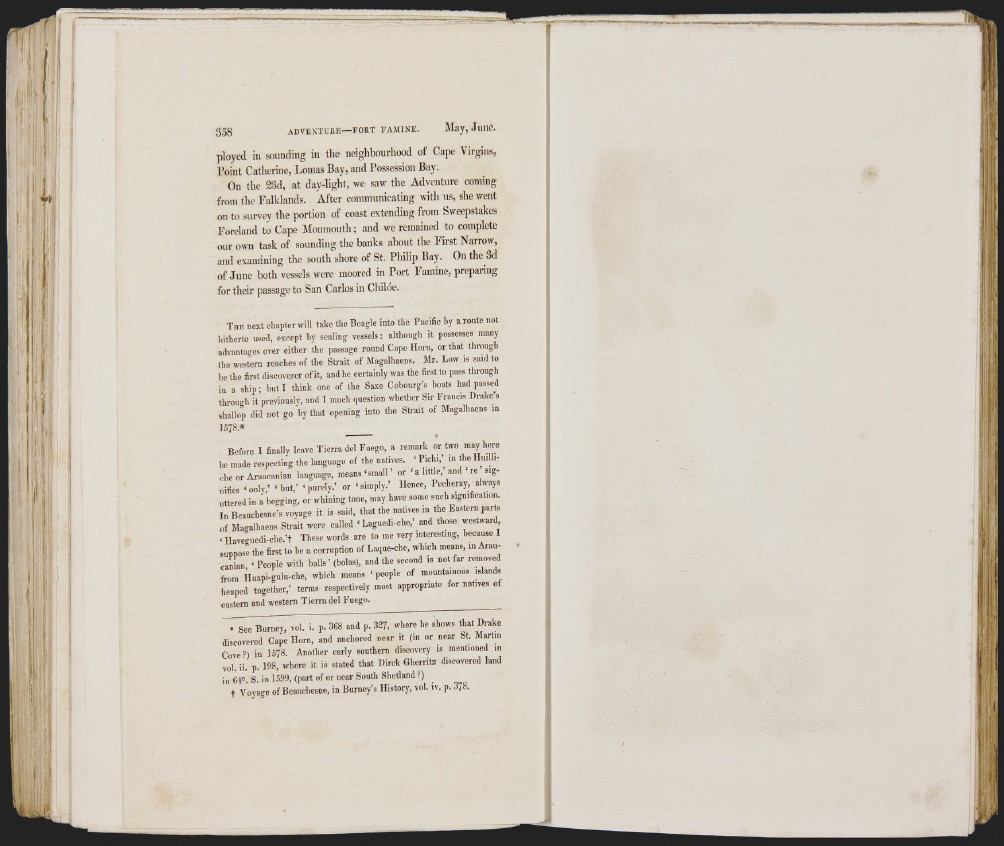
' *l i !
* 'j'i
! I
I!
■ r
358 ADVENTURE----FORT FAMINE. May, JullC.
ployed in sounding in the neighbourhood of Cape Virgins,
Point Catherine, Lomas Bay, and Possession Bay.
On the 23d, at day-light, we saw the Adventure coming
from the Falldands. After communicating with us, she went
on to survey the portion of coast extending from Sweepstakes
Foreland to Cape Monmouth; and we remained to complete
our own task of sounding the banks about the First Narrow,
and examining the south shore of St. Philip Bay. On the 3d
of June hoth vessels were moored in Port Famine, preparing
for their passage to San Carlos in Chiloe.
T h e next chapter will take the Beagle into the Pacific by a route not
hitherto used, except hy sealing vessels : although it possesses many
advantages over either the passage round Cape Horn, or that through
the western reaches of the Strait of Magalhaens. Mr. Low is said to
he the first discoverer of it, and he certainly was the first to pass through
in a sh ip ; but I think one of the Saxe Cobourg’s boats had passed
through it previously, and 1 much question whether Sir Francis Drake s
shallop did not g o by that opening into the Strait of Magalhaens in
1578.* — •
Before I finally leave T ie rra del Fuego, a remark or two
be made respecting the language of the natives. ‘ Piclii, in the Hmlli-
che or Araucanian language, means ‘ small ’ or ‘ a little, and re signifies
‘ only,’ ‘ hut,’ ‘ purely,’ or ‘ simply.’ Hence, Pecheray, always
uttered in a begging, or whining tone, may have some such signification.
In Beauchesne’s voyage it is said, that the natives in the Eastern parte
o f Magalhaens Strait were called ‘ Laguedi-che, and those westward
< Haveguedi-che.’t These words are to me very interesting, because I
suppose the first to be a corruption of Laque-che, w h i ^ means, in Araucanian
‘ People with balls ’ (bolas), and the second is not far removed
from Huapi-gulu-che, which means ‘ people of mountainous islands
heaped together,’ terras respectively most appropriate for natives of
eastern and western T ie rra del Fuego.
. See Burney, vol. 1. p. 368 and p. 327, where he shows that Drake
discovered Cape Horn, and anchored near it (in or near St. Martin
CoveP) in 1578. Another early southern discovery is mentioned in
vol. ii. p. 198, where it is stated that Dirck Glierritz discovered land
in 64'’. S. in 1599, (part of or near South Shetland ?)
t Voyage of Beauchesne, in Burney’s History, vol. iv. p. 378.
I ii